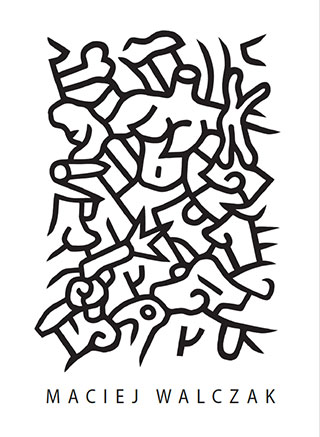 |
|
Maciej Walczak »
malarstwo, grafika, rysunek


On the dark side, on the bright side
.
Maciej Walczak addresses a wide range of street art
activities in his work. Although this art finds its way into
galleries and museums, it still functions as a kind of
tattoo carved on the body of the street. It is an important
aspect of modernity, drawing attention to itself with its
different nature of communication, both in terms of the
audience reach and the form taken.
Maciej Walczak, like the early medieval barbarians, fills
the entire surface of the plane with ducts of lines. That
is why he is eager to go out into the street. The scale of
the place allows him to freely appropriate the surface
there. It seems as if what he does is just a fragment of
a message that unfolds, in space and time - infinitely.
The painter's hand delineates the contours of dynamic
figures that enter into various relationships with one
another. The compositions are open, the lines go
somewhere in different directions, change course, the
outlines of the forms break off at the edges, escape
beyond the boundaries of the painting. Thus, the story
spun by Walczak never ends. This is because the author's
works are not born in isolation from the world in which
he functions this small (and not insignificant) personal
territory of the artist, as well as the social and historical
space with all its circumstances.
Walczak's street actions take on the character of
personal rituals, performed by a contemporary urban
shaman. Horror vacui in his realizations is some form of
compensating for deficiency, overcoming subconscious
premonitions and fears, urges and anger. In this sense,
artistic activity is a kind of therapeutic self-expression.
Maciej Walczak's visual representations grow out of
a particular culture and are an anarchizing opposition to
the official forms of communication operating in the street
space or the interiors of public buildings. They function
alongside flashy billboards and light boxes, other forms of
advertising and information. The author responds to their
garishness with his own visual noise. The complexity
of Walczak's messages is noticeably large, as large as the
abundance of everyday messages that reach us from all
sides. Reacting to the external chaos, the artist tries to
drown it out with an element released from its tether,
which with its dynamism and vitality corresponds to the
multiple sounds of the street. He reacts to the strangeness
and chaos of the surrounding space, and at the same
time tries to establish a bond with it. This is one of the
fundamental contradictions evident in Maciej Walczak's
artwork.
We most often associate graffiti with haste, spontaneity,
gesture. Walczak's compositions are, of course, vigorous
and vehement in their ultimate expression, in the
created tensions between characters, in the feelings
that can be defined. In the perceptible, though tamed,
emotional violence of the author.
However, in the very nature of the works created, one can
see a certain - perhaps incompatible with the chosen
convention - care, refinement of drawing, consciously
maintained continuity of narration. It is thanks to this that
we do not go by these compositions indifferently. Having
recognized a particular situation, we stop to follow the line
that leads us - to find the subsequent components of the
story, as in myths written in the artist's special personal
language. Contrary to expectations, Walczak does not use
a paintbrush in a chaotic manner - the forms he builds
are well thought out, drawn carefully and they enter into
various relationships with each other. The complex form
of his graffiti no longer requires the use of other spectacular
and garish means of expression. The street compositions are
in a sense modest - the artist has deliberately limited the
colour means of expression to black and white, for example.
Maciej Walczak does not hide his fascination with
selected cultural forms. He is inspired by myths, beliefs,
rituals. Ultimately, however, the works created must
correspond to an inner need and be an adequate
reflection of it. When the author is not satisfied with the
result, when the effect does not meet his expectations,
he destroys it, even if its creation was preceded by hours
of work. The sources of inspiration in Walczak's work are
discernible not only when he develops multi-meter wall
compositions. The vigorous nature of the street man is
also evident in his graphics and drawings.
There, from the beginning, one could also see that
tendency, characteristic of the author, to use numerous
possible concentrations in the visual layer; in doing so,
the artist departed from representational forms. The
bold handling of not always manageable stain of colour
as a means of expression is a testimony to a liberated
expression, originating in the subconscious, which is
resistant to unambiguous interpretations. Among other
things, it has its source in the mood accompanying creation,
reinforced by the character of the music listened to, which
often remains in correspondence with the visual work.
Maciej Walczak's drawings are enriched with new means
of expression. The contour of figural motifs is deepened
by the shadows cast by the forms, their perceptible
spatiality and depth are formed.
In graffiti, violent expression was sometimes curbed and
it remained at the level of the mental layer. In graphic art,
inner emotions can be accompanied by the use of more
brutal tools, passion has a more physical dimension.
A certain roughness and greater expressive power of the
finished works appear.
Maciek Walczak's compositions are a map of a journey
through the world full of contradictions. A journey made,
admittedly, with problems, but certainly not affected by
boredom.
Dariusz Leśnikowski
Translated by Elżbieta Rodzeń-Leśnikowska
Dariusz Leśnikowski

 KATALOG
KATALOG
|
|
|
 |









